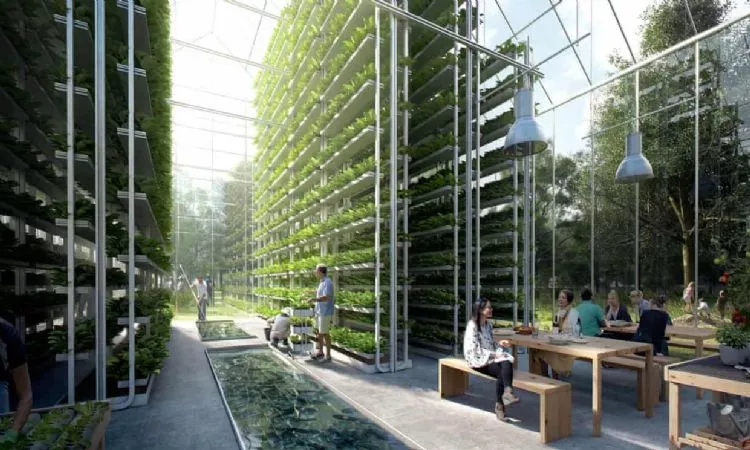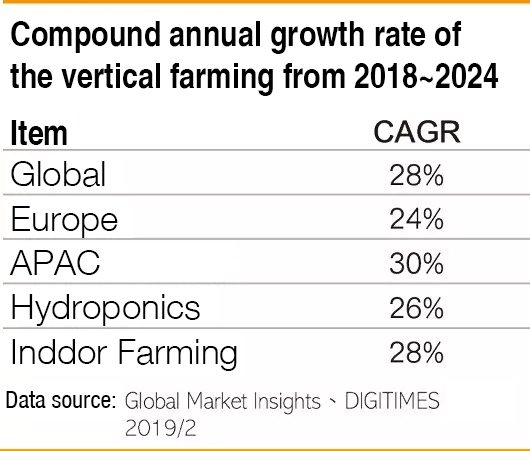Author: Zhang Chaoqin. Source: DIGITIMES
The rapid increase in population and the development trend of urbanization are expected to urge and promote the development and growth of the vertical farm industry. Vertical farms are considered to be able to solve some of the problems of food production, but whether it can be a sustainable solution for food production, experts believe that there are still challenges in fact.

According to reports by Food Navigator and The Guardian, as well as surveys by the United Nations, the global population will grow from the current 7.3 billion people to 8.5 billion people in 2030, and 9.7 billion people in 2050. FAO estimates that in order to meet and feed the population in 2050, food production will increase by 70% compared to 2007, and by 2050 global grain production must increase from 2.1 billion tons to 3 billion tons. Meat needs to be doubled, increasing to 470 million tons.
Adjusting and adding more land for agricultural production may not necessarily solve the problem in some countries. The UK has used 72% of its land for agricultural production, but still needs to import food. The United Kingdom is also trying to use other methods of farming, such as using air-raid tunnels left over from World War II for similar greenhouse planting. The initiator Richard Ballard also plans to expand the planting range in 2019.
On the other hand, water use is also an obstacle to food production. According to OECD statistics, about 70% of water use is for farms. Climate change also exacerbates production problems. Urbanization also requires the food production system to feed the rapidly growing urban population with fewer rural laborers, limited land and limited water resources. These issues are driving the development of vertical farms.
The low-use characteristics of vertical farms will bring opportunities to allow agricultural production to enter the city, and it can also be closer to urban consumers. The distance from the farm to the consumer is reduced, shortening the entire supply chain, and urban consumers will be more interested in food sources and easier access to fresh nutrition production. In the past, it was not easy for urban residents to access healthy fresh food. Vertical farms can be built directly in the kitchen or their own backyard. This will be the most important message conveyed by the development of vertical farms.

In addition, the adoption of the vertical farm model will have a broad impact on the traditional agricultural supply chain, and the use of traditional agricultural medicines such as synthetic fertilizers, pesticides and herbicides will be significantly reduced. On the other hand, the demand for HVAC systems and control systems will increase to maintain the best conditions for climate and river water management. Vertical agriculture generally uses special LED lights for simulating sunlight and other equipment to set the indoor or outdoor architecture.
The research and development of vertical farms also includes the aforementioned “smart technology” for monitoring environmental conditions and optimizing the use of water and minerals. The Internet of Things (IoT) technology will also play an important role. It can be used to record plant growth data. The harvest of crops will be traceable and monitored by computers or mobile phones in other places.
Vertical farms can produce more food with less land and water resources, and are far away from harmful chemical fertilizers and pesticides. However, the stacked shelves in the room require more energy than traditional agriculture. Even if there are windows in the room, artificial light is usually required due to other restrictive reasons. The climate control system can provide the best growing environment, but it is also quite energy intensive.
According to statistics from the UK Department of Agriculture, lettuce is grown in a greenhouse, and it is estimated that about 250 kWh (kilowatt hour) of energy is needed per square meter of planting area each year. According to the relevant collaborative research of the German DLR Research Center, a vertical farm of the same size planting area requires an astonishing energy consumption of 3,500 kWh per year. Therefore, how to improve acceptable energy use will be an important topic for the future technological development of vertical farms.
In addition, vertical farms also have investment funding problems. Once venture capitalists pull hands, commercial business will cease. For example, Paignton Zoo in Devon, UK, was founded in 2009. It was one of the earliest vertical farm startups. It used the VertiCrop system to grow leafy vegetables. Five years later, due to insufficient subsequent funds, the system also went into history. The follow-up company was Valcent, which later became Alterrus, and began to establish a rooftop greenhouse planting method in Canada, which eventually ended in bankruptcy.
Post time: Mar-30-2021

